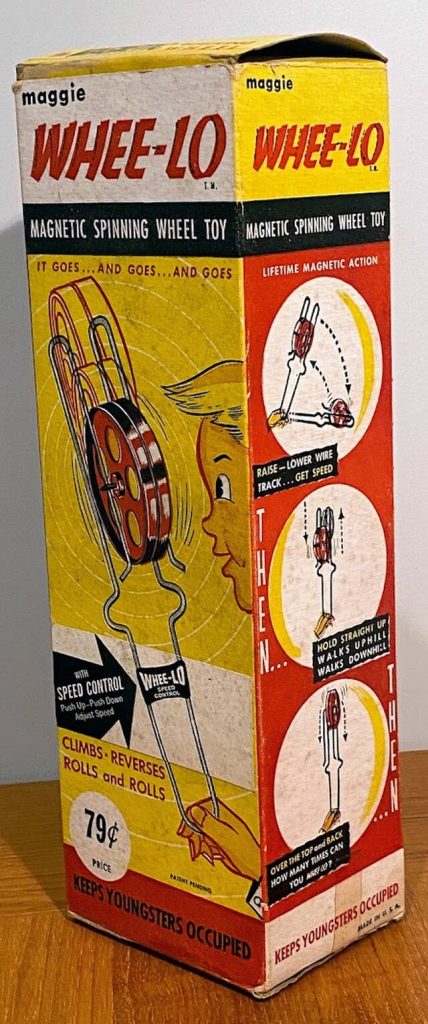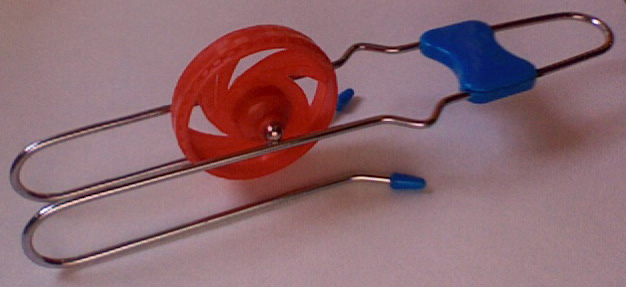There are many toys and activities that any of us born before 1970 probably remember with fondness, if we think about it long enough. One of my personal favorites was a “magical” wheel that spun back and forth on a curved, handheld track, propelled by the arm movements of its holder. The WHEE-LO, as it was once called, has a fascinating history that surpasses what one might expect from a non-digital entertainment device. From Communism in America to a fidget favorite, this simple mechanism is part of American pop culture.

What was the WHEE-LO?
A solid description of the device is a neat story all in itself. People, young and old, have discovered the mesmerizing physics behind the WHEE-LO, a classic handheld novelty. This captivating toy features a magnetized plastic wheel that spins perpetually along a bent wire track. By skillfully tipping the metal guide up and down, the user continuously propels the wheel. It rolls along the top of the track, transitions seamlessly to the bottom, then cycles to the opposite side, maintaining constant contact with the wire in a continuous loop. With practiced movement and rhythm, the wheel can achieve impressive rotational speeds.
The WHEE-LO brand name was formally registered in 1958, but its journey began in 1953, when the Maggie Magnetic company in New York City launched it. Early sets included six vibrant, interchangeable cardboard discs called “Whee-lets” that users attached to the wheel, generating dazzling optical illusions as the toy sped around the track.
According to the Burlingame Toy Museum site, the WHEE-LO sold for $0.79 in 1957, complete with those fabulous-sounding cardboard attachments mentioned earlier. It was perfect as a backseat activity on a long car ride, a sick-day entertainment device, or even a means of a family-and-friends contest.
Here is a link to the re-branded WHEE-LO, which, if purchased, helps this site earn a commission to cover costs. Your patronage is appreciated! Schylling’s Magnetic Gyro Wheel.
A Communist Plot?
The “Magic Rail Twirler” and “WHEE-LO” may have had original names quite different from “Stringless Yo-yo.” Based on his autobiography, The Stringless Yo-yo (which was also the title of his experimental film), Harvey Matusow claims to have invented the toy and transferred the intellectual property to the Maggie Magnetic company in the early 1950s.
Matusow may have been the creator of this engaging device, but he is more famous for entirely different reasons.
Harvey Matusow (1926–2002): The Perjurer, Informer, and Avant-Garde Artist
Harvey Matusow, born Harvey Marshall Matusow, was one of the most infamous and contradictory figures of the mid-20th century. He is primarily famous for his sensational, ultimately retracted testimony as a paid government witness during the anti-Communist fervor of the McCarthy Era.
Matusow was born in the Bronx in 1926 and, after serving in World War II, joined the American Communist Party in 1947. However, he became disillusioned and, in 1950, began working for the FBI as an undercover informant. He transitioned into a highly publicized career as a professional witness, testifying for various anti-subversion groups, including the House Un-American Activities Committee (HUAC) and the staff of Senator Joseph McCarthy. He was a central figure in the blocklisting of many alleged Communists, notably musicians from the popular folk group, The Weavers. Matusow’s livelihood depended on supplying names, a system critics called a “deadly farce.”
His infamy reached its peak in 1955, when he publicly recanted much of his testimony, admitting he had lied under pressure from government prosecutors and investigators. His tell-all book, False Witness (1955), detailed his career as a fabricator, sparking a national debate on the government’s use of paid informers. While his recantation helped discredit the anti-Communist witch hunts, Matusow was subsequently convicted of perjury and sentenced to three years in prison, as the government claimed he had lied previously.
Following his release, Matusow’s life took several dramatic turns. Blocked from finding work in the US, he moved to England in the mid-1960s and reinvented himself within the counterculture art scene. He was an avant-garde artist, a co-founder of the influential underground newspaper The International Times, a BBC radio broadcaster, a jazz musician, and a performer.
Ultimately, Matusow remains a complex and controversial figure whose personal trajectory—from devoted Communist to star informer, convicted perjurer, and eccentric artist—mirrored the political and cultural upheaval of his time.
Conclusion
So, what are we left with? The story of the WHEE-LO, that mesmerizing, gravity-defying toy beloved by a generation, now possesses a bizarre spin. On one hand, you have the captivating object itself: a simple, elegant piece of physics that enchanted millions of children throughout the 1960s. On the other hand, you have the man who claimed to invent it: Harvey Matusow, an admitted perjurer whose explosive, false testimony helped fuel the paranoid darkness of the McCarthy Red Scare.
It’s a bizarre collision of American history—the symbol of innocence and simple fun, potentially brought to life by one of the era’s most infamous fabricators and accused Communist sympathizers. Whether Matusow genuinely engineered the WHEE-LO or merely co-opted its story, the irony is profound. A man whose life was defined by lies, political betrayal, and chaos may have also been the one to give the world a toy of pure, cyclical, almost hypnotic order. When you pick up that little magnetic wheel today, remember you might be holding a piece of Cold War irony wrapped in a yo-yo without a string.
Many of us who played with the WHEE-LO probably don’t even remember what it was called, let alone its connection with its alleged controversial creator. The fond memories of being entertained with the magnetic wheel and its curved track take us back to simpler times and happy thoughts.
